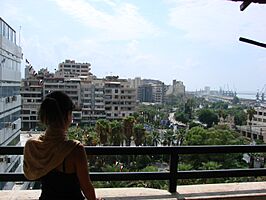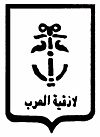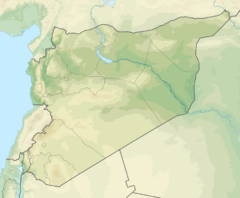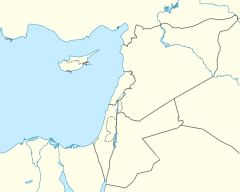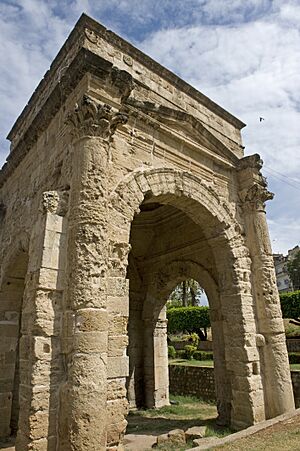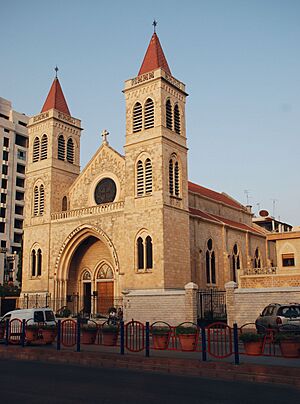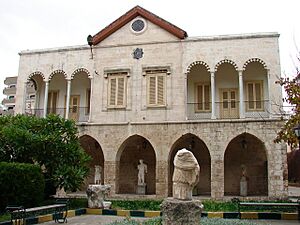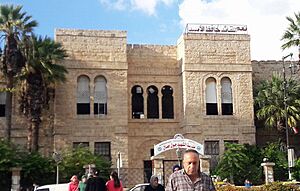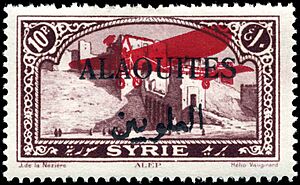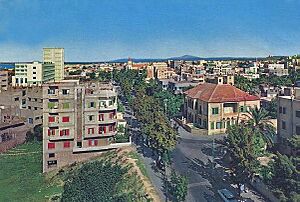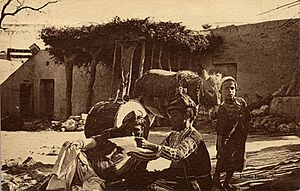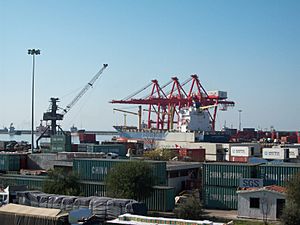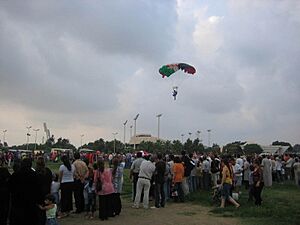Latakia facts for kids
Quick facts for kids
Latakia
ٱللَّاذْقِيَّة / ٱللَّاذِقِيَّة
Laodicea
|
||
|---|---|---|
|
City
|
||
|
Downtown view • The governor's palace
Port of Latakia • National Museum of Latakia Al-Assad Stadium • Latakia Sports City |
||
|
||
| Nickname(s):
"Bride of the Mediterranean"
|
||
| Country | ||
| Governorate | Latakia Governorate | |
| District | Latakia District | |
| Subdistrict | Latakia Subdistrict | |
| Founded | 4th Century BC | |
| Founded by | King Seleucus I Nicator | |
| Area | ||
| • Land | 58 km2 (22 sq mi) | |
| • Metro | 108 km2 (42 sq mi) | |
| Elevation | 11 m (36 ft) | |
| Population
(2023 Estimate)
|
||
| • City | 709,000 | |
| • Metro | 709,000 | |
| • Metro density | 6,560/km2 (17,000/sq mi) | |
| Demonym(s) | Arabic: لاذقاني, romanized: Lādhqani | |
| Time zone | UTC+2 (EET) | |
| • Summer (DST) | UTC+3 (EEST) | |
| Area code(s) | Country code: 963 City code: 41 |
|
| Geocode | C3480 | |
| Climate | Csa | |
| International airport | Bassel Al-Assad International Airport | |
| Website | eLatakia | |
Latakia (Arabic: ٱللَّاذْقِيَّة, romanized: al-Lādhiqiyya) is a major port city in Syria. It is the capital of the Latakia Governorate and is located right on the Mediterranean coast. Long ago, it was also known as Laodicea in Syria. Besides being a busy port, Latakia is also an important place for making goods from nearby farms. In 2023, about 709,000 people lived in the city. Its population grew a lot because many people moved there from other areas during the Syrian Civil War. Latakia is the fourth-largest city in Syria, after Aleppo, Damascus, and Homs.
People have lived in this area since about 2000 BC. The city of Latakia was officially started in the 4th century BC by the Seleucid Empire. Over time, many different groups ruled Latakia. These included the Romans, Byzantines, and various Arab empires like the Rashiduns and Abbasids. Later, the city was ruled by the Seljuk Turks, Crusaders, Ayyubids, Mamluks, and the Ottomans. After World War I, Latakia became part of the French mandate of Syria. It was even the capital of a special area for the Alawite people, which later rejoined Syria in 1944.
Contents
What's in a Name?
Like many cities built by the Seleucid Empire, Latakia was named after someone important in the ruling family. Seleucus I Nicator named it Laodikeia on the Coast after his mother, Laodice. In Latin, it was called Laodicea ad Mare. The Arabic name, al-Ladhiqiyyah, comes from this original name. From Arabic, we get the French Lattaquié and the English Latakia. The Ottomans called it Lazkiye.
A Look at Latakia's Past
Early Settlements and Founding
The area where Latakia stands, called the Ras Ziyarah promontory, has been lived in for a very long time. An ancient Phoenician city called Ramitha was once here. Old writings say the city was also known as Leukê Aktê, meaning "white coast," before it became Laodicea.
An ancient writer named Strabo described the city in his book Geographica. He said it was "beautifully built" with a "good harbour." He also mentioned that the mountains near the city were covered in grapevines, producing a lot of wine. This wine was sent to other cities like Alexandria.
Roman Rule and Growth
In the 1st century BC, Pompey the Great took control of Latakia and much of Syria. Later, Julius Caesar declared Latakia a "free polis," meaning it had some self-rule. In the 2nd century AD, the Roman emperor Septimius Severus gave the city the special title of "Metropolis." He also removed some taxes, made the city stronger, and built the famous Tetraporticus arch. A Roman road was built, which helped trade through Latakia's port.
The city was known for its wine, which was shipped all over the Roman Empire. After the Roman Empire split, Latakia became part of the Eastern Roman Empire. An earthquake damaged the city in 494 AD, but Emperor Justinian I rebuilt it. It became the capital of a Roman province until Muslim forces took control around 637 AD.
Early Islamic Era
After the Muslim conquest of Syria in the 7th century, Latakia came under Muslim rule. It was renamed al-Lādhiqīyah. It was ruled by different Islamic empires, including the Rashidun Caliphate, Umayyad Caliphate, and Abbasid Caliphate. An Arab geographer named Al-Muqaddasi wrote in the 10th century that al-Lādhiqīyah was part of the Hims region.
Crusaders, Ayyubids, and Mamluks
From the 8th to the 10th centuries, Latakia was often fought over by the Byzantine Empire and Arab powers. The Byzantines would sometimes recapture it, only to lose it again. In 1097, during the First Crusade, ships from Cyprus raided the city. In 1098, Raymond of Saint-Gilles captured Latakia. The city then became a point of conflict between the Crusaders and the Byzantines.
In 1103, Tancred, Prince of Galilee, a Crusader leader, took control of the city. Latakia became an important port for the Principality of Antioch, a Crusader state. The city was damaged by earthquakes in 1157 and 1170. In 1188, the Ayyubids, led by Saladin, captured Latakia. The Crusaders briefly took it back in 1260, but the Mamluks finally conquered it in 1287.
Around 1300, an Arab geographer noted that Latakia's port was "wonderful" and full of large ships. In the 14th and 15th centuries, traders from Venice had a representative in Latakia because of the trade in cotton and silk. The city was rebuilt after a visit by Qaitbay in 1477.
Ottoman Rule
Latakia became part of the Ottoman Empire after the Battle of Marj Dabiq in 1516. In the 16th century, about 1,400 to 1,700 people lived there. The city grew quickly in the 18th century, partly because of the tobacco industry. British, French, and Spanish countries set up consulates (offices for their representatives) in the city. By the mid-1700s, Latakia was an important city in the region.
During the Ottoman period, the area around Latakia became mostly home to the Alawites, a religious group. The city itself had many Sunni Muslims and Christians. The Alawites had a difficult relationship with the Ottoman rulers, but they had some freedom.
French Mandate Period
After World War I, in 1920, Latakia came under French control as part of the French Mandate for Syria. The French created a special area called the Alawite State, named after the Alawite people who lived there. This state was meant to protect the Alawites, who were different from the Sunni majority.
However, some Alawites, like Sheikh Saleh al-Ali, protested against French rule. His revolt was stopped in 1921. The Alawite State joined the Syrian Federation in 1922 but left in 1924. In 1930, it was renamed the Government of Latakia. Finally, in 1936, it was decided that the Alawite State would become part of Syria again. This happened in 1937.
In 1942, Latakia and other regions were fully returned to Syrian control. By 1946, the French left Syria, and a new independent government was formed.
Modern Latakia
Most of the old Roman buildings in Latakia were destroyed over time, often by earthquakes. However, some parts remain, like a Roman arch and columns. Important ancient items like statues and pottery are now in the city's national museum.
A large port project began in 1950, and the Port of Latakia was built. This made the city much more important for trade. By 1951, the first part of the port was finished, and it handled more and more of Syria's trade with other countries.
In 1968, a major highway connected Latakia to Aleppo and the Euphrates valley. A railway line to Homs was also completed. The port became even more vital after 1975 because of problems in Lebanon, which affected the ports of Beirut and Tripoli.
In 1973, during the Yom Kippur War, a naval battle called the Battle of Latakia happened near the city. This was one of the first battles where missiles and electronic defenses were used.
In 1987, Latakia hosted the 1987 Mediterranean Games, a big sports event. The Latakia Sports City complex was built especially for these games.
By 1994, Latakia's population was 303,000. It grew to 383,786 by 2004. In recent years, the population has increased a lot due to people moving from other Syrian cities affected by conflict.
Latakia During the Syrian Civil War

Since March 2011, Latakia has seen some protest activities. The Syrian government reported clashes, and the military was sent to the city. Many people were arrested. Protests continued, and some civilians were harmed in conflicts with security forces. In August 2011, the Syrian Army and Syrian Navy began an operation in the city.
Latakia is home to a large Russian military base called Khmeimim Air Base. This base is important for Russia's operations in Syria. In December 2017, Russian President Vladimir Putin visited the base with Syrian President Bashar al-Assad. He announced that some Russian forces would leave, but the base would continue to operate.
In December 2021, the port of Latakia was attacked by Israeli warplanes. The attacks damaged port facilities and caused fires.
Latakia's Location and Weather
Where is Latakia?
Latakia is located about 348 kilometers (216 miles) northwest of Damascus. It is 186 kilometers (116 miles) southwest of Aleppo and 90 kilometers (56 miles) north of Tartus. Nearby towns include Kasab to the north, and Jableh and Baniyas to the south.
Latakia is the capital of the Latakia Governorate in western Syria. This area borders Turkey to the north. The Nahr al-Kabir al-Shamali river flows into the Mediterranean Sea just south of Latakia.
What is Latakia's Climate Like?
Latakia has a hot-summer Mediterranean climate. This means it has warm, humid summers and cool, wet winters. The wettest months are December and January, with a lot of rain. July is the driest month, with very little rain, but it can still be quite humid.
The average high temperature in January is about 15.4°C (59.7°F), and in August, it's around 29.6°C (85.3°F). Latakia gets about 811 millimeters (31.9 inches) of rain each year.
| Climate data for Latakia (1961–1990, extremes 1928–present) | |||||||||||||
|---|---|---|---|---|---|---|---|---|---|---|---|---|---|
| Month | Jan | Feb | Mar | Apr | May | Jun | Jul | Aug | Sep | Oct | Nov | Dec | Year |
| Record high °C (°F) | 24.4 (75.9) |
26.3 (79.3) |
32.6 (90.7) |
35.6 (96.1) |
38.8 (101.8) |
38.4 (101.1) |
36.2 (97.2) |
38.4 (101.1) |
38.2 (100.8) |
39.0 (102.2) |
32.6 (90.7) |
28.0 (82.4) |
39.0 (102.2) |
| Mean daily maximum °C (°F) | 15.4 (59.7) |
16.4 (61.5) |
18.3 (64.9) |
21.5 (70.7) |
24.1 (75.4) |
25.8 (78.4) |
28.8 (83.8) |
29.6 (85.3) |
29.0 (84.2) |
26.3 (79.3) |
21.9 (71.4) |
17.6 (63.7) |
22.9 (73.2) |
| Daily mean °C (°F) | 11.6 (52.9) |
12.6 (54.7) |
14.8 (58.6) |
17.8 (64.0) |
20.7 (69.3) |
23.8 (74.8) |
26.3 (79.3) |
27.0 (80.6) |
25.6 (78.1) |
22.3 (72.1) |
17.5 (63.5) |
13.3 (55.9) |
19.4 (66.9) |
| Mean daily minimum °C (°F) | 8.4 (47.1) |
9.1 (48.4) |
11.0 (51.8) |
14.0 (57.2) |
17.0 (62.6) |
20.7 (69.3) |
23.7 (74.7) |
24.3 (75.7) |
21.9 (71.4) |
18.2 (64.8) |
13.8 (56.8) |
10.1 (50.2) |
16.0 (60.8) |
| Record low °C (°F) | −1.6 (29.1) |
−0.5 (31.1) |
−0.6 (30.9) |
3.9 (39.0) |
10.6 (51.1) |
11.7 (53.1) |
17.8 (64.0) |
17.2 (63.0) |
12.4 (54.3) |
8.9 (48.0) |
0.0 (32.0) |
0.0 (32.0) |
−1.6 (29.1) |
| Average precipitation mm (inches) | 185.2 (7.29) |
97.0 (3.82) |
91.5 (3.60) |
48.5 (1.91) |
22.4 (0.88) |
5.2 (0.20) |
1.3 (0.05) |
2.3 (0.09) |
8.0 (0.31) |
69.3 (2.73) |
95.5 (3.76) |
185.2 (7.29) |
811.4 (31.94) |
| Average precipitation days (≥ 1.0 mm) | 11.3 | 9.3 | 8.4 | 4.6 | 2.7 | 1.0 | 0.3 | 0.3 | 1.0 | 5.2 | 6.6 | 11.0 | 61.7 |
| Average relative humidity (%) | 63 | 62 | 65 | 68 | 72 | 74 | 74 | 73 | 68 | 62 | 57 | 65 | 67 |
| Mean monthly sunshine hours | 136.4 | 148.4 | 198.4 | 225.0 | 297.6 | 321.0 | 325.5 | 316.2 | 288.0 | 248.0 | 192.0 | 151.9 | 2,848.4 |
| Mean daily sunshine hours | 4.4 | 5.3 | 6.4 | 7.5 | 9.6 | 10.7 | 10.5 | 10.2 | 9.6 | 8.0 | 6.4 | 4.9 | 7.8 |
| Source 1: NOAA | |||||||||||||
| Source 2: Deutscher Wetterdienst (humidity, 1966–1978), Meteo Climat (record highs and lows) | |||||||||||||
| Climate data for Bassel Al-Assad International Airport (1991–2020) | |||||||||||||
|---|---|---|---|---|---|---|---|---|---|---|---|---|---|
| Month | Jan | Feb | Mar | Apr | May | Jun | Jul | Aug | Sep | Oct | Nov | Dec | Year |
| Record high °C (°F) | 25.0 (77.0) |
26.8 (80.2) |
32.8 (91.0) |
36.8 (98.2) |
40.0 (104.0) |
40.0 (104.0) |
36.5 (97.7) |
38.5 (101.3) |
41.0 (105.8) |
39.0 (102.2) |
33.1 (91.6) |
28.4 (83.1) |
41.0 (105.8) |
| Mean daily maximum °C (°F) | 16.6 (61.9) |
17.3 (63.1) |
19.6 (67.3) |
22.5 (72.5) |
25.6 (78.1) |
28.2 (82.8) |
30.3 (86.5) |
31.2 (88.2) |
30.3 (86.5) |
28.2 (82.8) |
23.1 (73.6) |
18.4 (65.1) |
24.3 (75.7) |
| Mean daily minimum °C (°F) | 7.2 (45.0) |
7.7 (45.9) |
9.7 (49.5) |
12.3 (54.1) |
15.5 (59.9) |
18.9 (66.0) |
21.6 (70.9) |
22.6 (72.7) |
20.5 (68.9) |
17.2 (63.0) |
12.1 (53.8) |
8.5 (47.3) |
14.5 (58.1) |
| Record low °C (°F) | −3.0 (26.6) |
−3.2 (26.2) |
0.0 (32.0) |
2.0 (35.6) |
9.8 (49.6) |
13.0 (55.4) |
16.8 (62.2) |
18.3 (64.9) |
13.3 (55.9) |
7.6 (45.7) |
2.0 (35.6) |
−3.0 (26.6) |
−3.2 (26.2) |
| Average precipitation mm (inches) | 175.1 (6.89) |
131.5 (5.18) |
86.3 (3.40) |
52.6 (2.07) |
28.3 (1.11) |
8.0 (0.31) |
0.1 (0.00) |
3.7 (0.15) |
15.0 (0.59) |
56.7 (2.23) |
95.4 (3.76) |
172.8 (6.80) |
836.2 (32.92) |
| Average precipitation days (≥ 1.0 mm) | 12.0 | 10.2 | 8.1 | 5.9 | 3.3 | 0.7 | 0.1 | 0.4 | 1.6 | 4.7 | 6.3 | 10.9 | 64.1 |
| Source: NCEI | |||||||||||||
Who Lives in Latakia?
In 1825, a count showed that Latakia had about 6,000 to 8,000 Muslims, 1,000 Greek Orthodox Christians, and smaller numbers of other groups. By 1905, the population was around 25,000. In 1994, it reached 303,000. By 2002, about 402,000 people lived there.
In 2010, about half of Latakia's city population was Alawite, 40% Sunni Muslim, and 10% Christian. However, the countryside around Latakia has a larger Alawite majority. Latakia is a main cultural center for the Alawite people. Many Alawites moved from this area to Damascus in the 1980s and 1990s.
Among the Christians, there is a large Antiochian Greek community. Their church in Latakia has the biggest group of followers for the Greek Orthodox Church of Antioch. There is also an Armenian community of about 3,500 people. Almost everyone in the city speaks Arabic, mostly the North Levantine dialect.
Inside the city, there is an "unofficial" Latakia camp for Palestinian refugees. It was set up in 1956 and is home to over 6,000 refugees, mainly from Jaffa and Galilee.
Latakia's Economy
The Port of Latakia
The Port of Latakia is Syria's most important seaport. It was opened on February 12, 1950, and has made the city much more important for trade. The port handles many types of goods. These include clothes, building materials, vehicles, furniture, minerals, and food items like grains and fruits. In 2008, the port handled about 8 million tons of cargo.
The largest part of the port is the container terminal, which is 43 hectares (about 106 acres) big. It can store up to 17,000 shipping containers. Latakia used to have ferry lines connecting it to cities like Alexandria (Egypt), İzmir (Turkey), and Beirut (Lebanon).
The Latakia marina has space for 150 boats up to 25 meters (82 feet) long. The Syrian Navy also has one of its four bases in Latakia.
Farming and Industry
Latakia is surrounded by a large farming area. The city exports things like bitumen (asphalt), grains, cotton, fruits, eggs, and tobacco. Local industries in the city include processing cotton, making vegetable oil, tanning leather, and sponge fishing.
Tourism and Fun Activities
The Cote d'Azur Beach in Latakia is a top coastal resort in Syria. Here, you can enjoy water skiing, jet skiing, and windsurfing. The city has eight hotels, including two five-star hotels located north of the city at Cote d'Azur.
In Latakia, people enjoy looking at shop windows and taking evening walks in the markets. Many stores with famous brands are found on 8 Azar Street. The main shopping area is around 8 Azar Street, Yarmouk Street, and Saad Zaghloul Street in the city center. Latakia also has movie theaters like Ugarit Cinema and al-Kindi.
Culture and Sports
Festivals in Latakia
The Al-Mahabba Festival is held every year in Latakia. It includes many fun activities like competitions, art shows, and tours to important historical and tourist sites in the city. This festival is organized by local businesses and a charity group.
Latakia's Museums
The National Museum of Latakia was built in 1986 near the sea. It used to be the home of the Governor of the Alawite State. Before that, it was a 16th-century Ottoman khan (an inn for travelers) called Khan al-Dukhan, meaning "The Khan of Smoke," because it was used for the tobacco trade.
The museum's exhibits include ancient tablets from Ugarit, old jewelry, coins, statues, and pottery. It also has chain-mail suits and swords from the early Arab and Crusader times.
Since the Syrian Civil War began in 2011, the museum has been temporarily closed to protect its valuable items from theft. However, the museum's gardens are still open to the public. You can see many old column tops, decorations, tombs, and statues there.
Sports in Latakia
Latakia is home to three football (soccer) clubs: Tishreen Sports Club, Hutteen Sports Club, and Tadamon SC. All these teams play at the al-Assad Stadium, which can hold 28,000 people. North of the city is the Latakia Sports City complex. It was built in 1987 to host the Mediterranean Games.
Latakia Tobacco
Latakia tobacco is a special type of tobacco. It was first made in Syria and named after the port city of Latakia. Today, most of this tobacco is produced in Cyprus. It is dried over a fire made from stone pine or oak wood. This gives it a strong, smoky, and peppery taste and smell. Latakia tobacco is rarely smoked by itself. Instead, it is mixed with other tobaccos to create special blends, especially in English and Balkan tobacco mixes.
Education in Latakia
The University of Latakia was started in May 1971. It was later renamed Tishreen University ("October University") in 1976 to remember the October War of 1973. When it first opened, the university had only three departments and about 983 students. Over the years, it has grown a lot, now having more than 70,000 students. This makes Tishreen University the third largest in Syria. It now has 17 departments, including Medicine, Pharmacy, Dentistry, Science, and Engineering.
The city also has a branch of the Arab Academy for Science and Technology and Maritime Transport. In 2016, a private university called Manara University was founded in Latakia. It offers studies in Pharmacy, Health, Engineering, and Business.
What to See in Latakia
The modern city of Latakia still has some signs of its ancient past. You can find an old gateway and other ancient items. There are also old tombs and caves nearby. The gateway is a remarkable arch with four entrances, similar to an old Roman arch. It is thought to have been built to honor a Roman emperor.
Important places to visit nearby include the huge Saladin's Castle and the ruins of Ugarit. At Ugarit, some of the very first alphabetic writings were discovered. There are also several popular beaches. Latakia has many mosques, including the Great Mosque from the 13th century and the Jadid Mosque from the 18th century.
Latakia has consulates for Finland and France, and honorary consulates for Greece and Romania.
Getting Around Latakia
Healthcare Services
The Syrian government runs three main public hospitals in Latakia: Al-Assad Hospital, the National Hospital, and the Tishreen University Hospital. There are also private hospitals.
Transportation in Latakia
Roads connect Latakia to major cities like Aleppo, Beirut, Homs, and Tripoli. The main coastal road in the city is Jamal Abdel Nasser Street, named after a former Egyptian president. This street has hotels, restaurants, and the city museum.
You can get around much of the city by taxi and other public transport. Buses take people to various cities in Syria, Lebanon, and Turkey, including Damascus, Aleppo, and Homs. The main bus station is on Abdel Qader al-Husseini Street. There is also an older bus station that sends buses when they are full. Smaller microbuses run between different parts of the city.
Latakia's railway station is on al-Yaman Square. Trains used to run daily to Aleppo and weekly to Damascus. In 2005, over 500,000 passengers used the railway station.
The Bassel Al-Assad International Airport is about 25 kilometers (15.5 miles) south of Latakia. It is the main airport for the city, with regular flights to places like Sharjah, Jeddah, Riyadh, and Cairo. The Port of Latakia also connects to cruise lines and sometimes has ferries to Cyprus. In 2005, about 27,939 passengers used the port.
Famous People from Latakia
- Themison of Laodicea, a doctor who started a medical school.
- Philonides of Laodicea, a philosopher and mathematician.
- Theodas of Laodicea, a philosopher and doctor.
- Apollinaris of Laodicea, a bishop.
- Yusuf Yasin, a journalist and politician.
- Hanna Mina, a novelist.
- Bassem Yakhour, an actor.
- Mustafa Hamsho, a professional boxer.
Sister Cities
Latakia is connected with these cities:
 Afyonkarahisar, Turkey
Afyonkarahisar, Turkey Sousse, Tunisia
Sousse, Tunisia /
/ Yalta, Ukraine/Russia (disputed)
Yalta, Ukraine/Russia (disputed)
Images for kids
See also
 In Spanish: Latakia para niños
In Spanish: Latakia para niños


